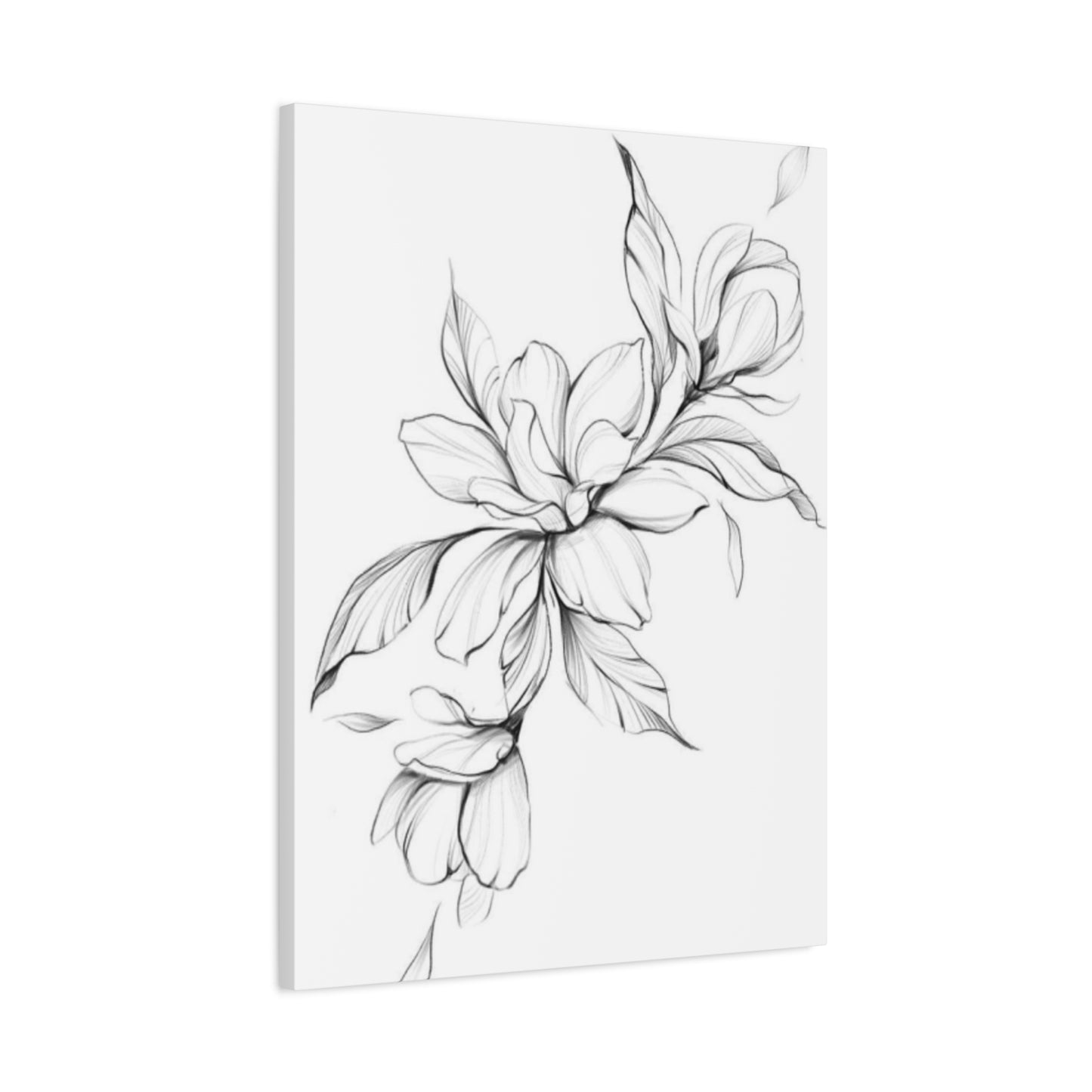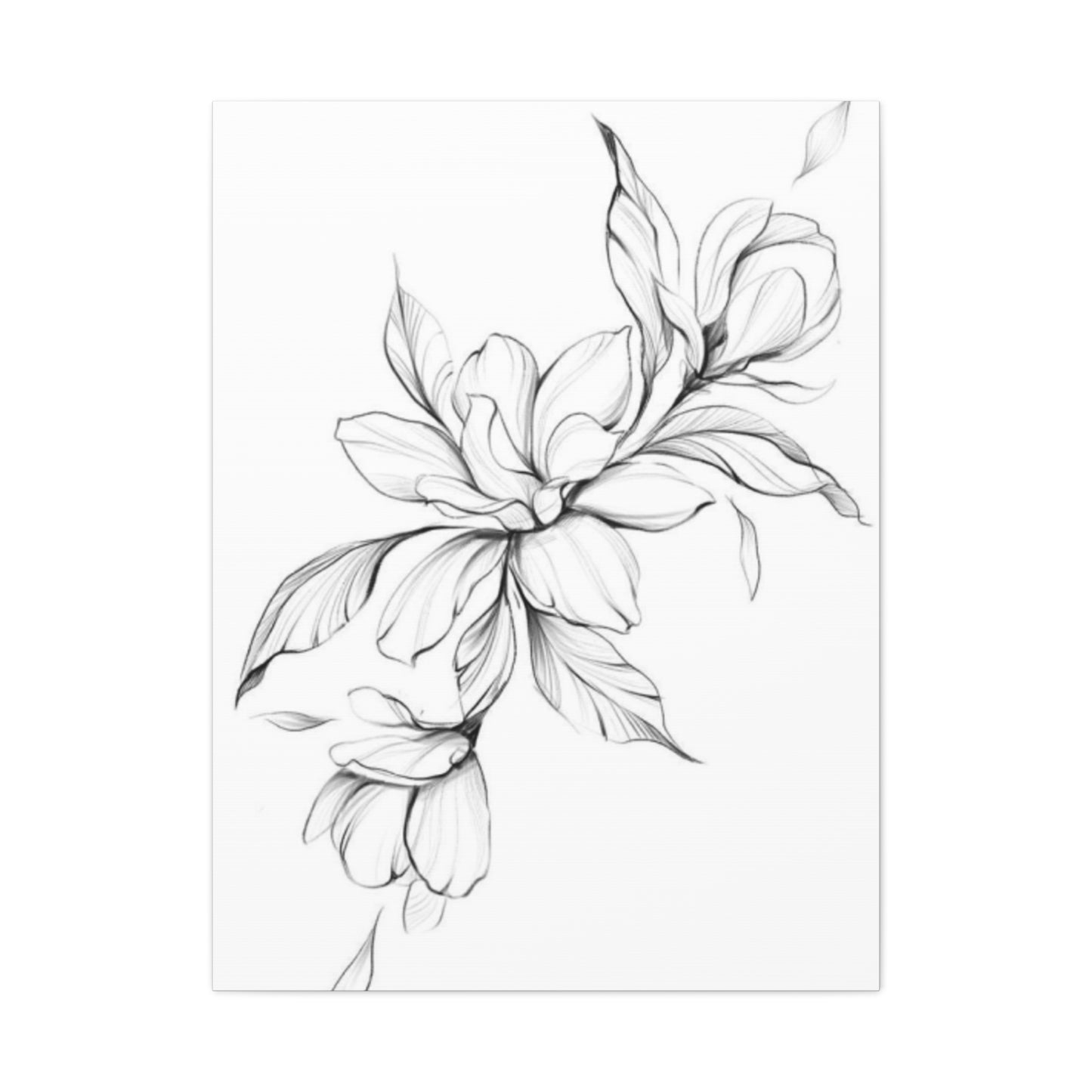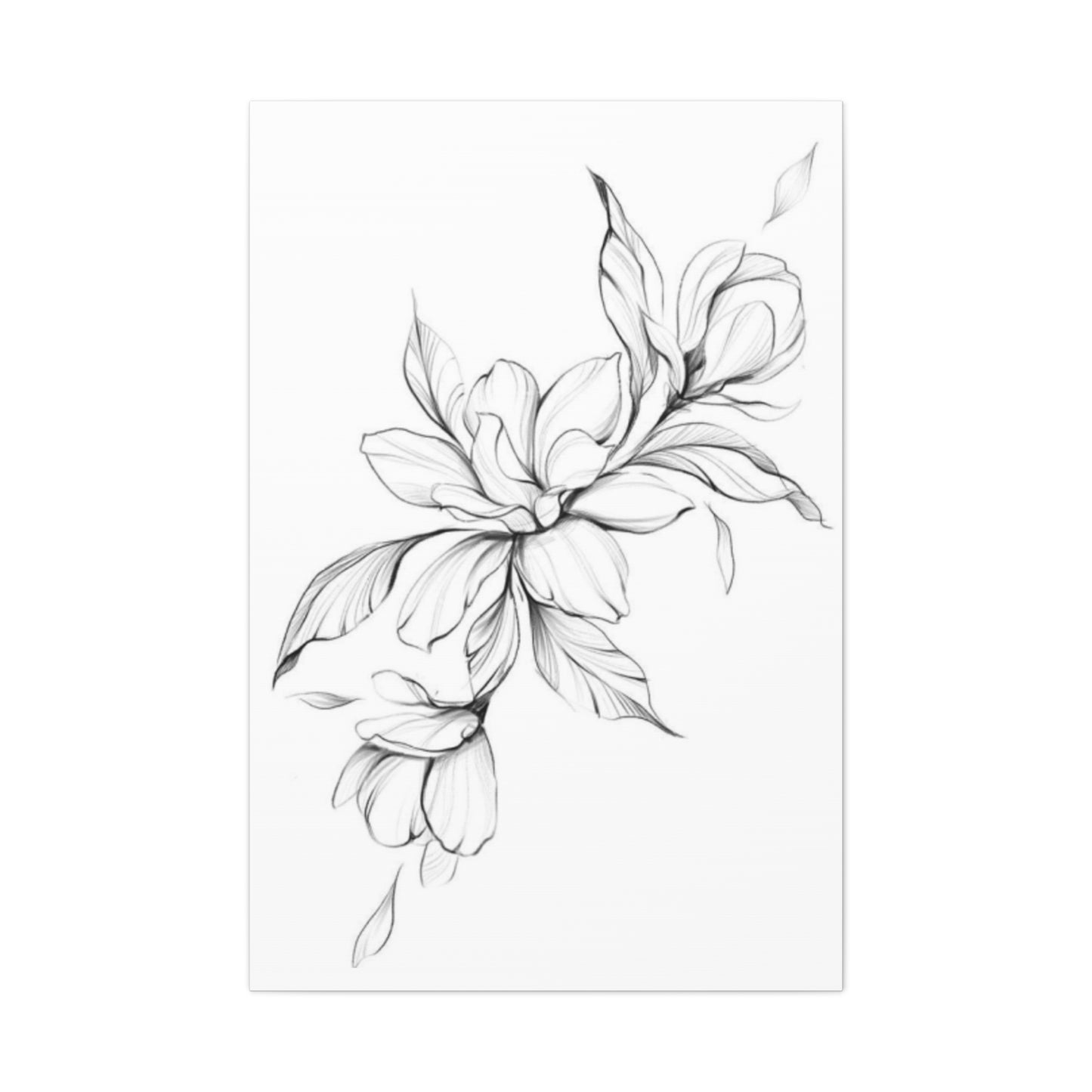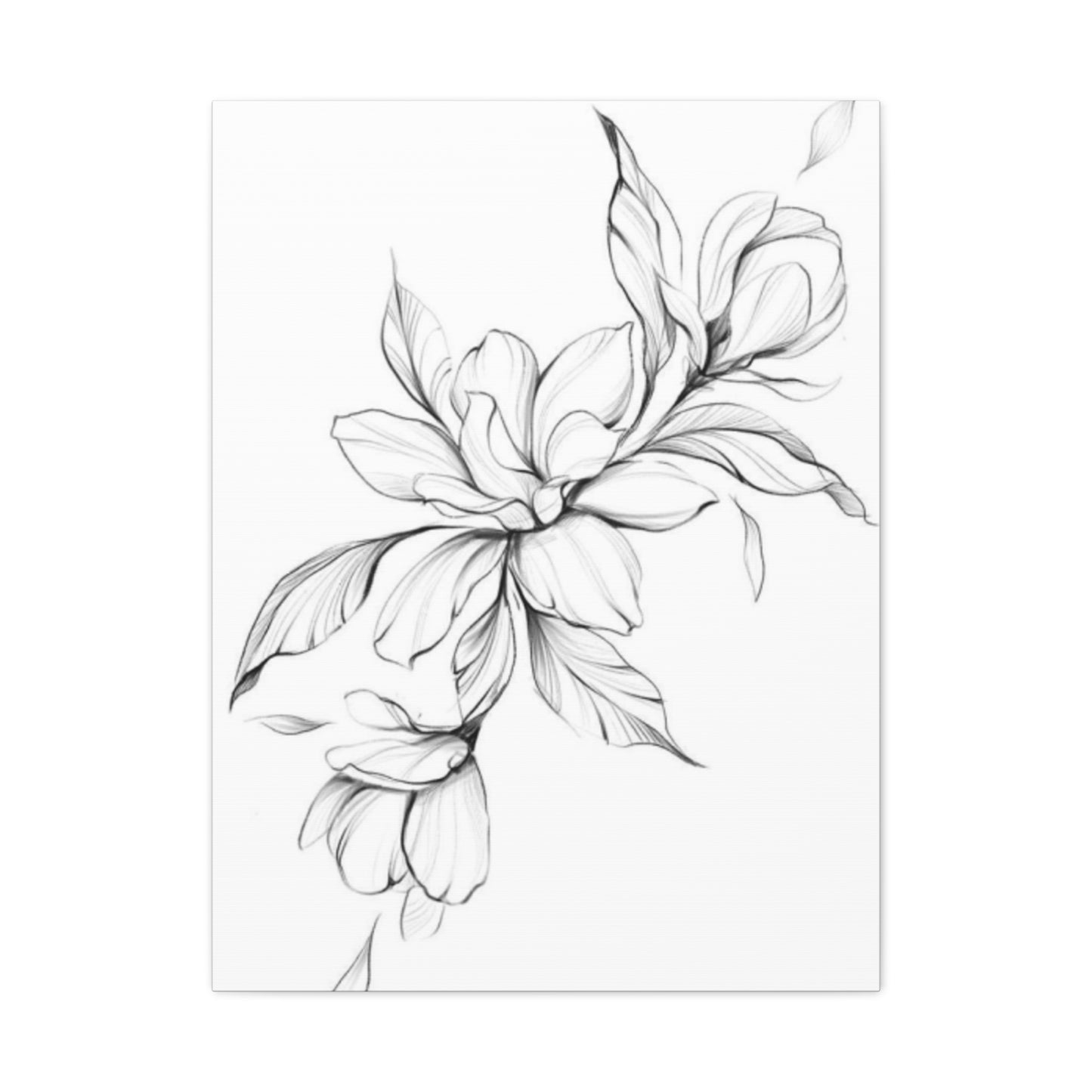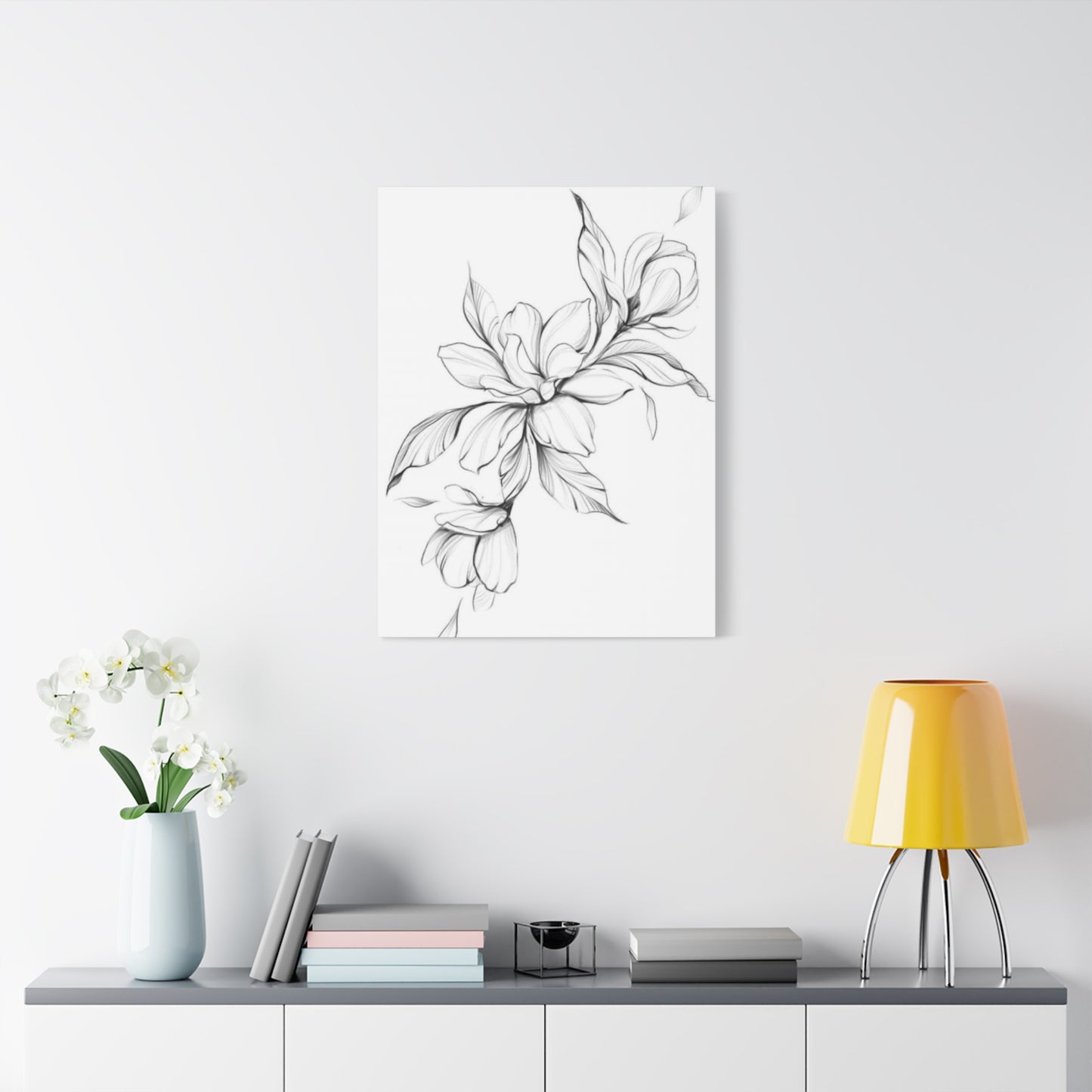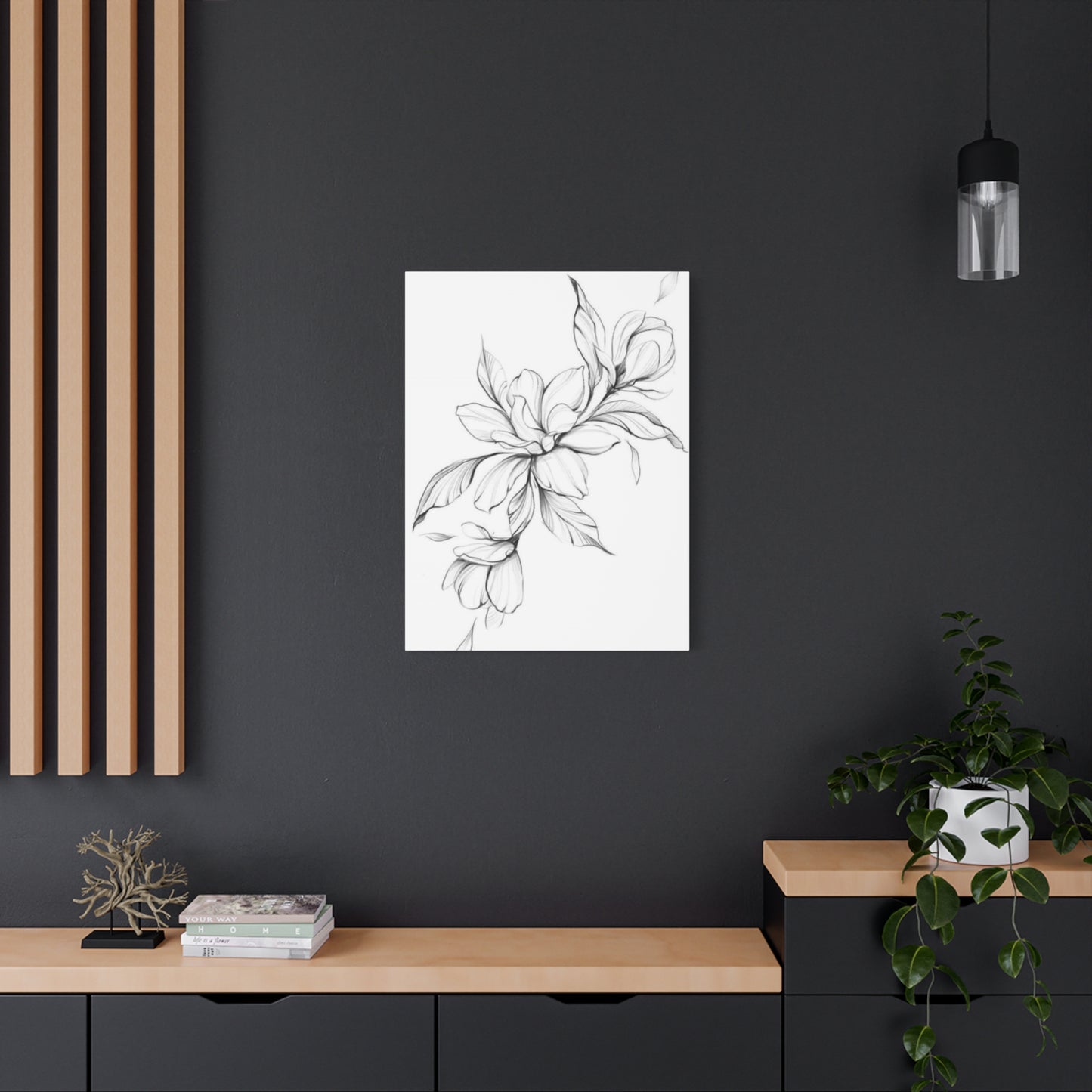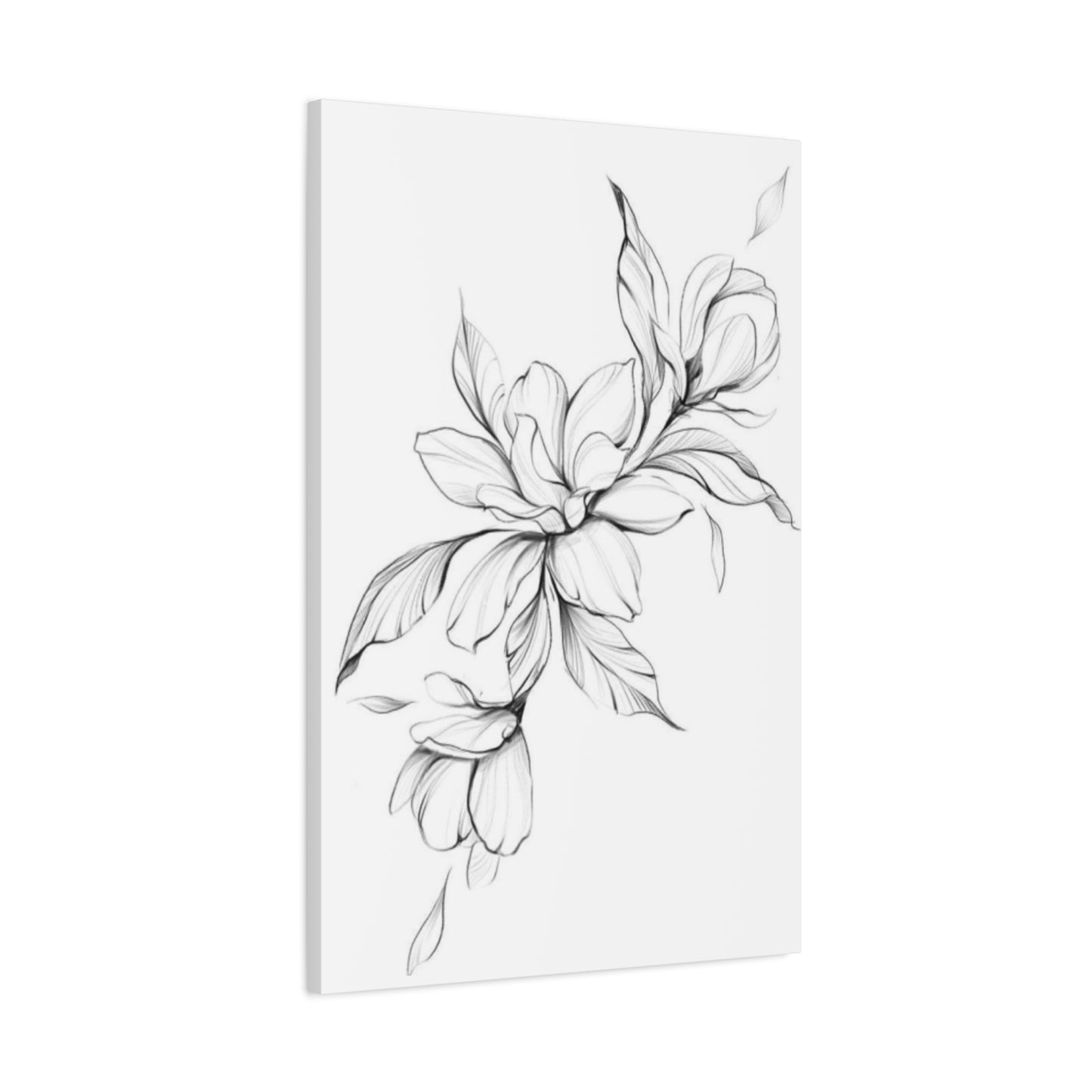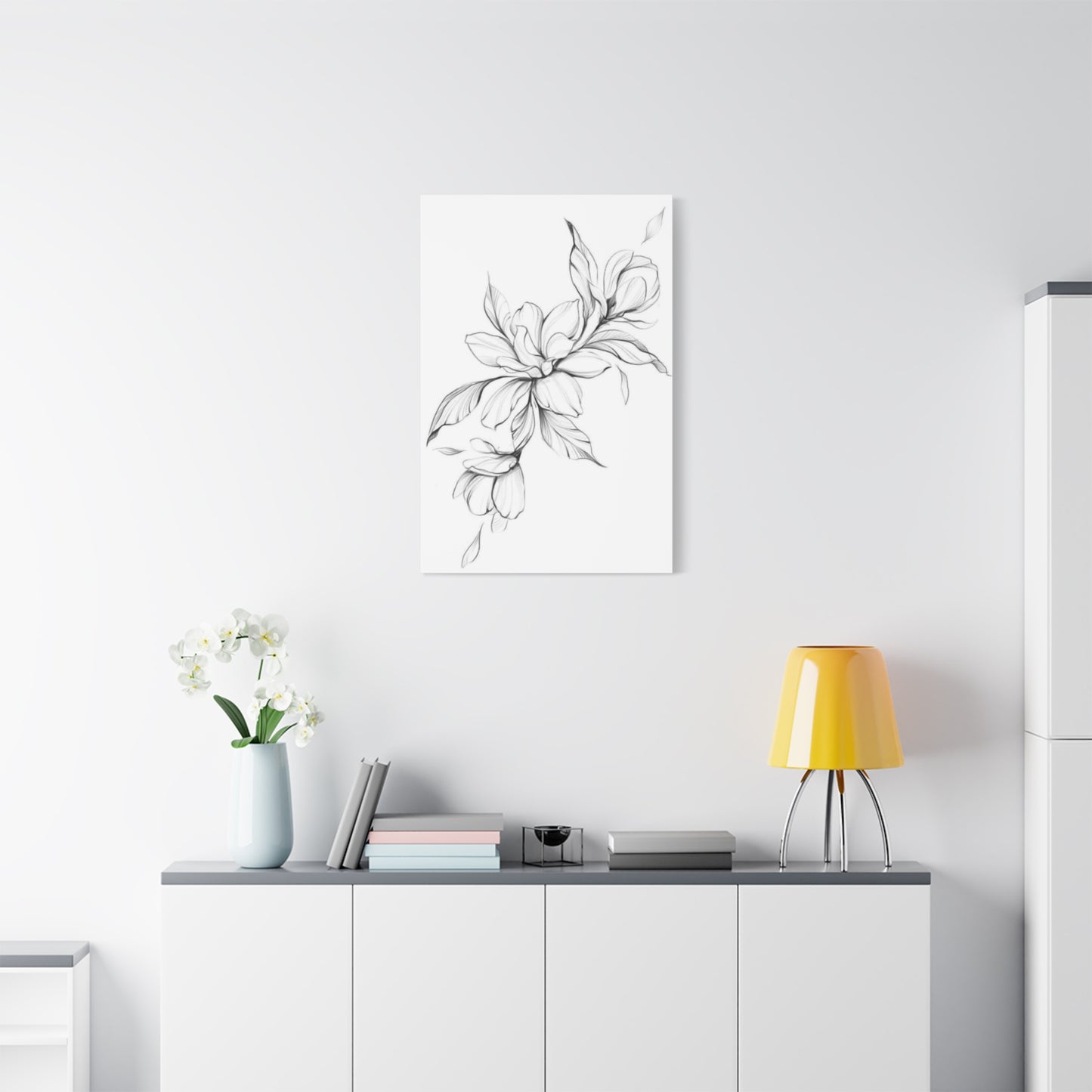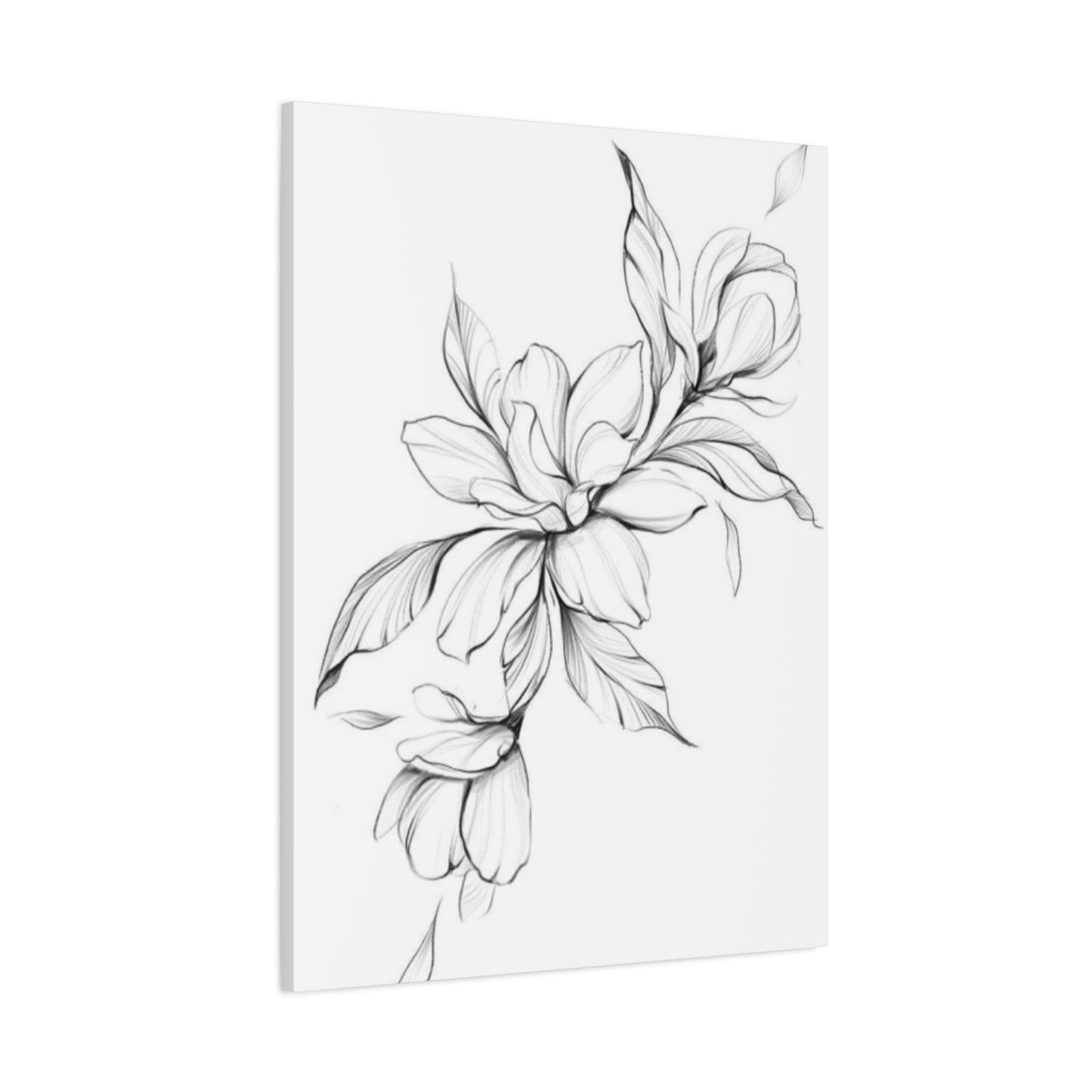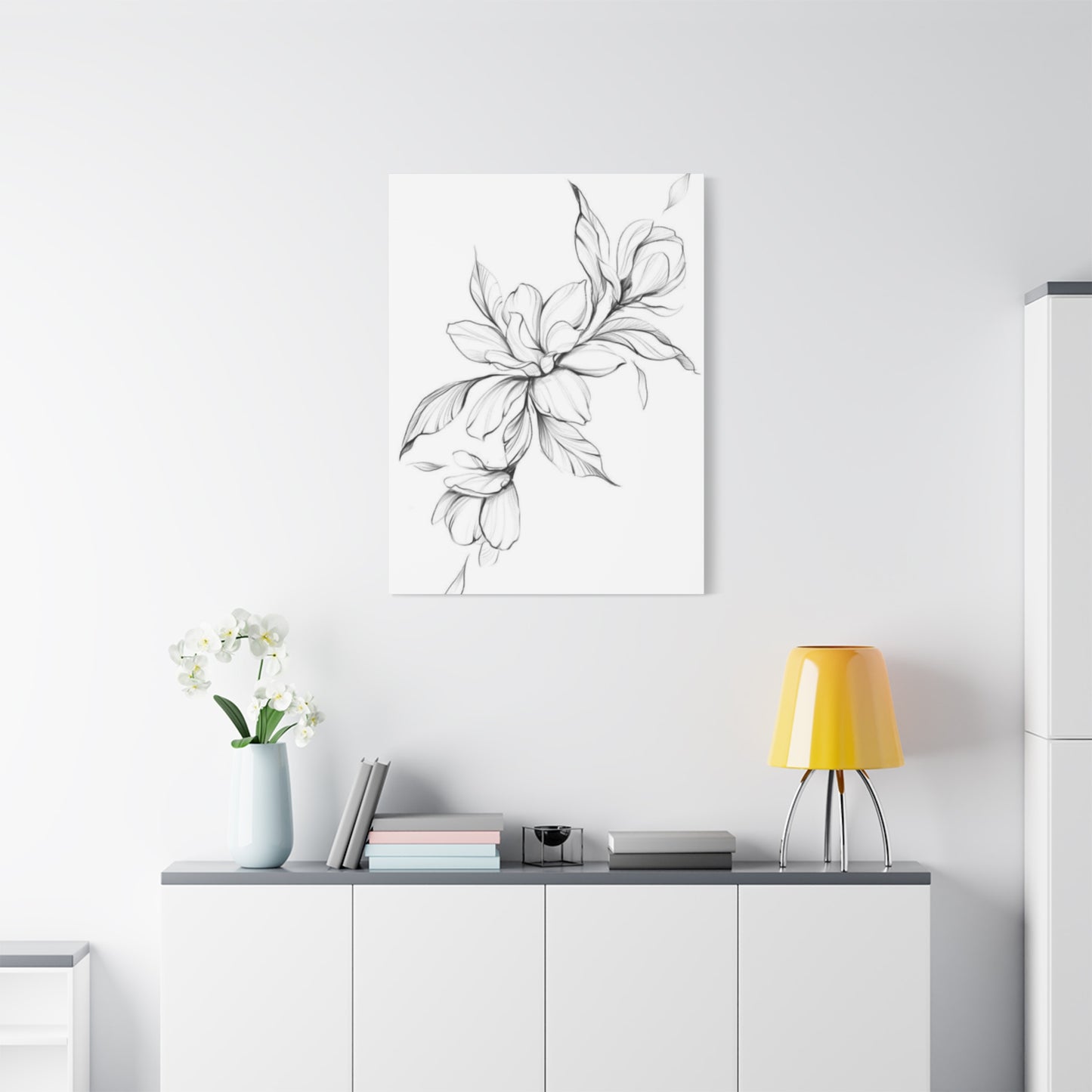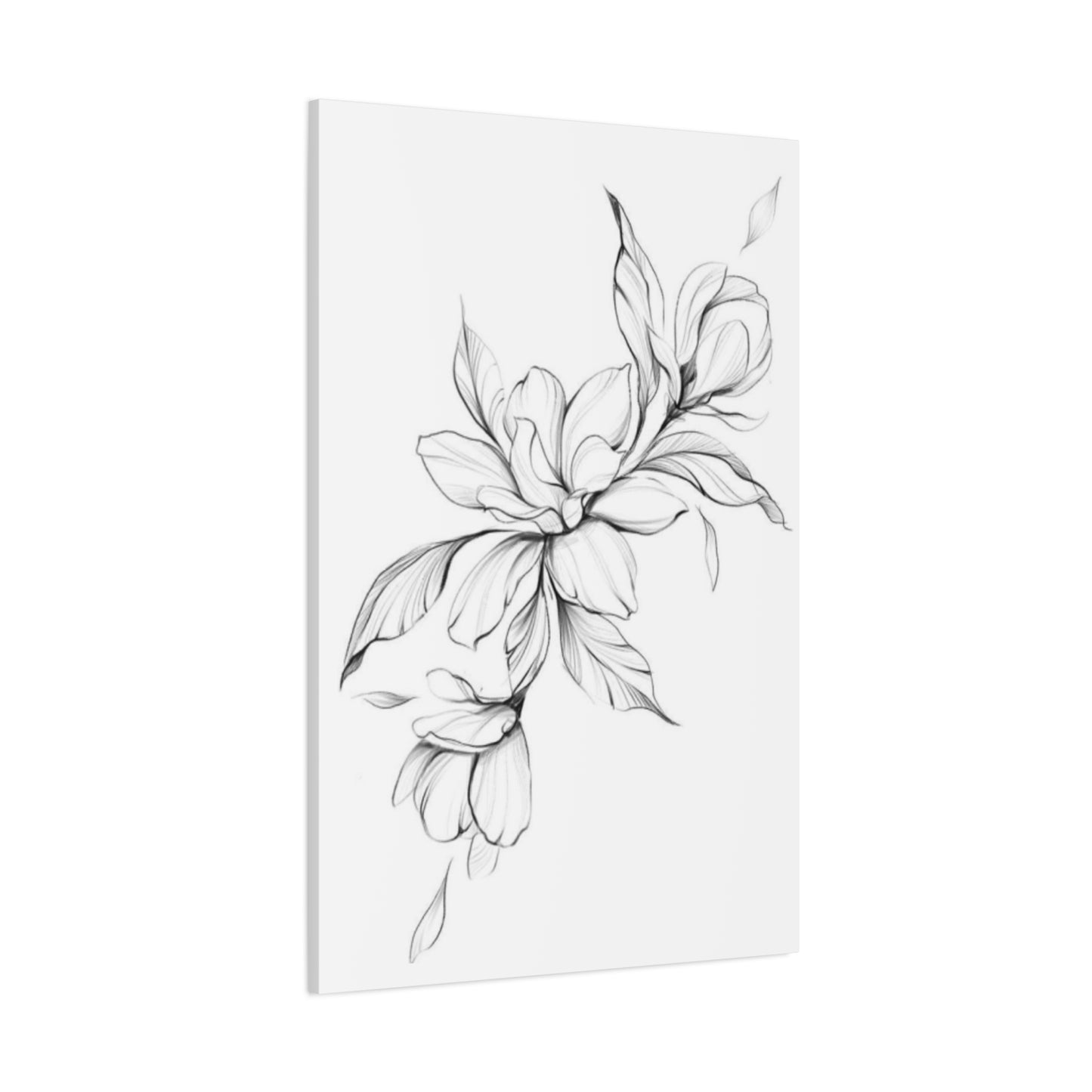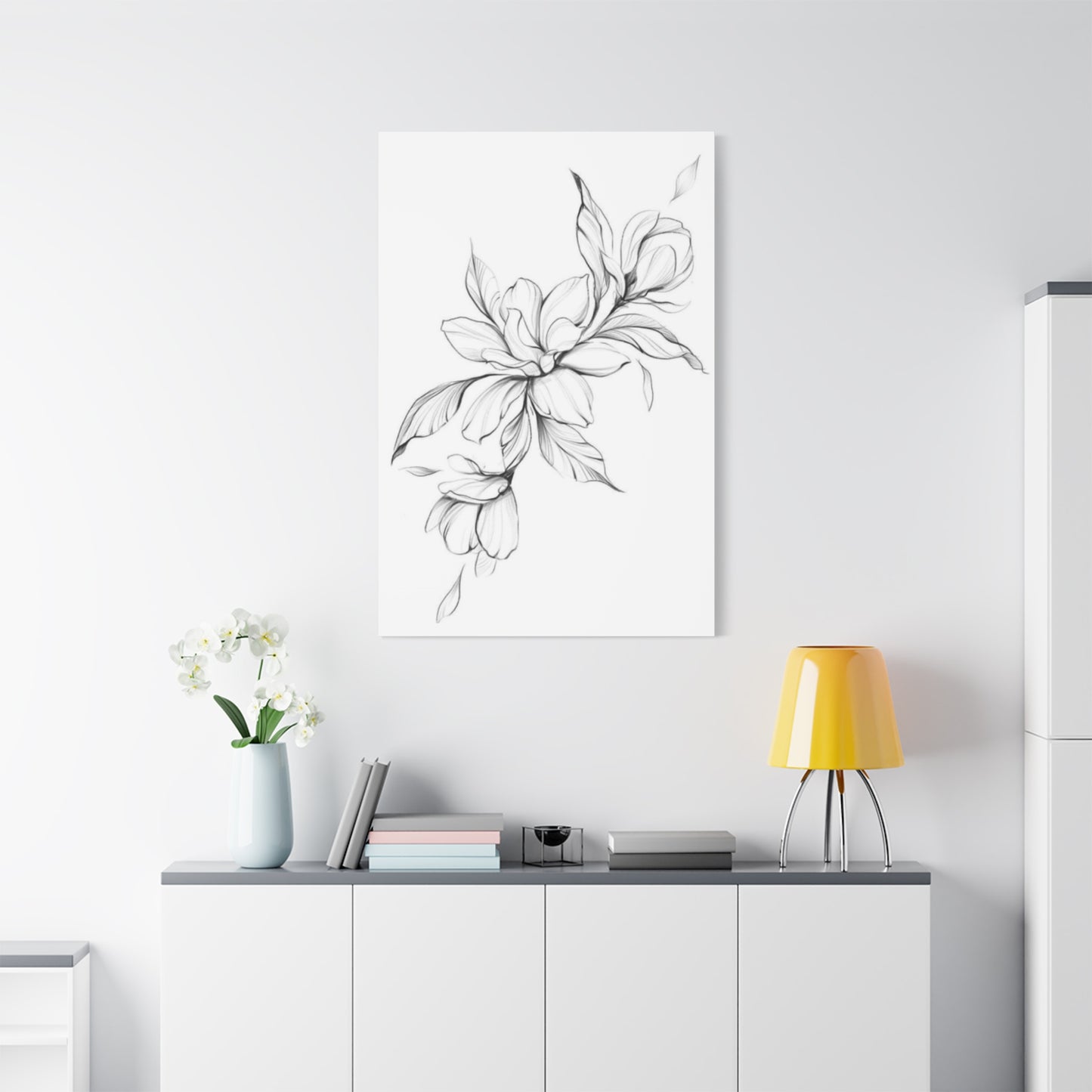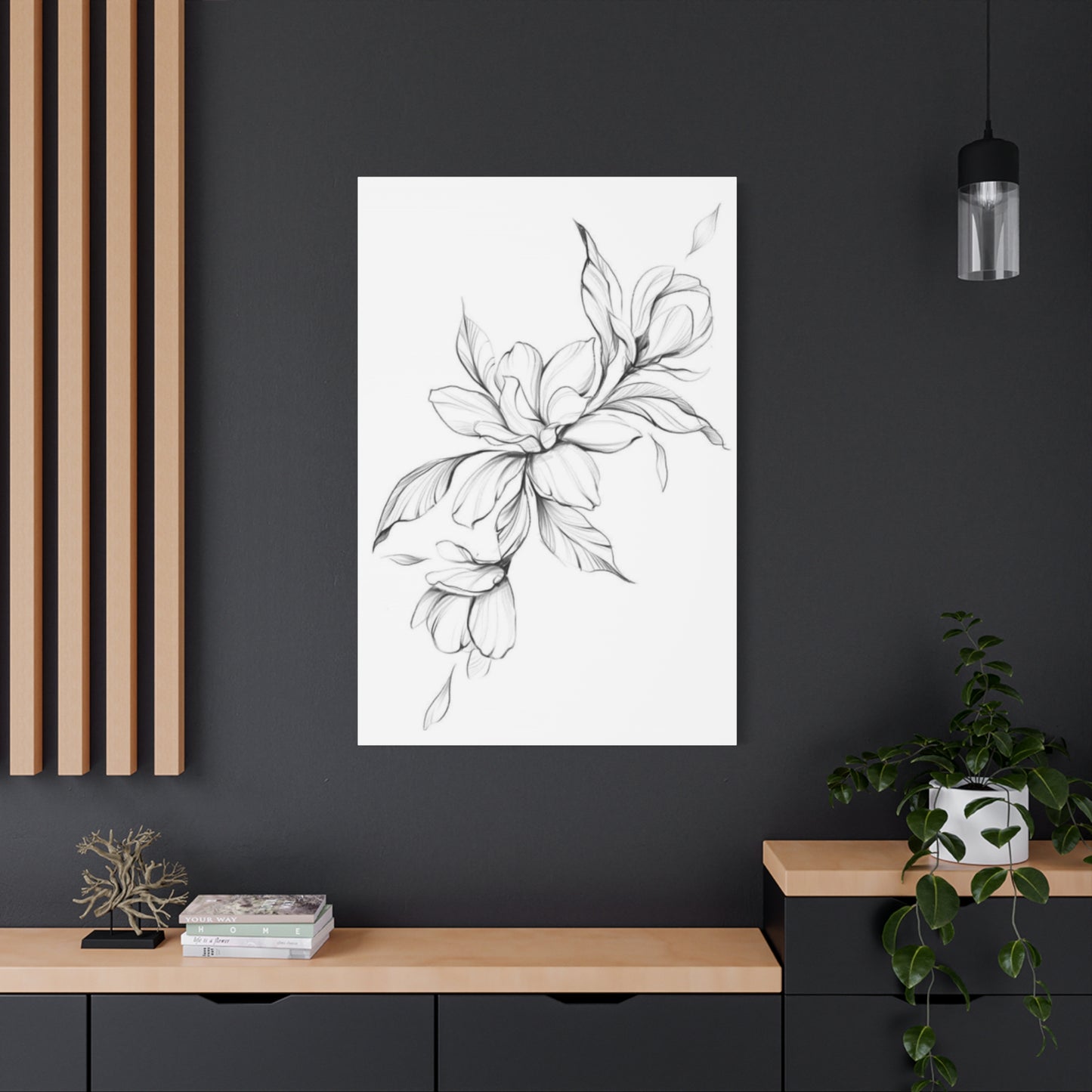Elegant Greyscale Magnolia Flower Painting Wall Art Canvas Prints for Modern Living
Greyscale magnolia flower painting wall art canvas prints have emerged as one of the most sophisticated and versatile decorative elements in modern home decoration. These stunning botanical artworks capture the essence of one of nature's most elegant blooms while maintaining the classic appeal that only monochrome artwork can provide. The magnolia flower, with its large, sculptural petals and graceful form, translates beautifully into greyscale interpretations that complement virtually any color scheme or decorative style.
The popularity of magnolia flower artwork stems from both its aesthetic appeal and symbolic significance. Magnolias represent dignity, nobility, and perseverance, making them ideal subjects for artwork that seeks to convey sophistication and strength. When rendered in greyscale tones, these flowers take on an even more refined appearance, stripping away the distraction of color to focus purely on form, texture, and composition.
Canvas prints offer the perfect medium for showcasing magnolia flower paintings, providing a texture and depth that enhances the natural beauty of the botanical subject matter. The canvas surface adds a subtle texture that complements the organic forms of the magnolia petals, while the printing process allows for remarkable detail reproduction that captures every nuance of the original artwork.
Modern homeowners are increasingly drawn to greyscale magnolia flower painting wall art canvas prints because they offer the perfect balance between natural beauty and contemporary sophistication. Unlike colorful floral artwork that might clash with existing decor or go out of style, greyscale magnolia prints provide a timeless elegance that works well in any setting, from minimalist modern homes to traditional Victorian residences.
The versatility of these pieces extends beyond their color neutrality. Magnolia flowers, with their simple yet dramatic forms, work equally well as single statement pieces or as part of larger gallery walls. Their organic shapes provide a pleasing contrast to the geometric lines often found in modern furniture and architecture, while their monochromatic palette ensures they never overwhelm the existing decor.
Historical Significance and Cultural Meaning Behind Magnolia Flower Art
The magnolia flower has held special significance in various cultures throughout history, making it a meaningful choice for home decoration. In ancient China, magnolias were associated with feminine beauty and gentleness, while in the American South, they became symbols of hospitality and dignity. This rich cultural heritage adds depth and meaning to magnolia flower artwork, making it more than just a decorative element.
Artists have been drawn to magnolia flowers for centuries, captivated by their perfect symmetry and elegant form. The large, waxy petals provide an ideal subject for exploring light, shadow, and texture in artistic representations. When translated into greyscale, these elements become even more prominent, allowing viewers to appreciate the subtle gradations of tone that give the flowers their three-dimensional quality.
The tradition of botanical art, which includes magnolia flower paintings, has its roots in scientific illustration. Early botanists and artists worked together to create detailed representations of plant species for educational and documentary purposes. This heritage of precision and attention to detail continues to influence contemporary magnolia flower artwork, ensuring that modern interpretations maintain the accuracy and beauty that make these pieces so appealing.
In modern art history, the magnolia flower has appeared in the works of many renowned artists, each bringing their own interpretation to this classic subject. From Georgia O'Keeffe's iconic magnolia paintings to contemporary botanical artists, the flower continues to inspire new generations of creators who find endless possibilities in its elegant form.
The symbolic meanings associated with magnolia flowers make them particularly appropriate for home decoration. Their representation of perseverance and strength makes them ideal for living rooms and common areas where families gather, while their association with beauty and elegance makes them perfect for bedrooms and private retreats.
Advantages of Choosing Canvas Prints for Magnolia Flower Artwork
Canvas prints have revolutionized the way we display artwork in our homes, offering numerous advantages over traditional framed prints or original paintings. For magnolia flower artwork, canvas prints provide several specific benefits that enhance the overall impact and longevity of the pieces.
The texture of canvas naturally complements the organic subject matter of magnolia flowers. The subtle weave of the canvas surface adds depth and interest to the printed image, creating a tactile quality that invites closer inspection. This texture is particularly effective with greyscale magnolia flower paintings, as it enhances the interplay of light and shadow that gives these pieces their dramatic impact.
Durability is another significant advantage of canvas prints. Unlike paper prints that can fade, tear, or become damaged by humidity, canvas prints are designed to withstand the test of time. The canvas material is stretched over a wooden frame, creating a rigid structure that resists warping and maintains its shape over years of display. This durability makes canvas prints an excellent investment for homeowners who want artwork that will continue to look beautiful for decades.
The printing process used for canvas prints allows for exceptional detail reproduction and color accuracy. Modern digital printing technology can capture the finest nuances of the original artwork, ensuring that every subtle gradation of grey in a magnolia flower painting is faithfully reproduced. This level of detail is crucial for botanical artwork, where the beauty often lies in the delicate variations of tone and texture.
Canvas prints also offer practical advantages in terms of hanging and display. Most canvas prints come ready to hang, with the canvas already stretched over a frame that includes hanging hardware. This eliminates the need for additional framing, making installation quick and easy. The lightweight nature of canvas prints also makes them safer to hang than heavy framed pieces, reducing the risk of accidents.
From an economic standpoint, canvas prints offer excellent value for money. They provide the visual impact of original paintings or expensive framed prints at a fraction of the cost, making high-quality artwork accessible to a broader range of homeowners. This affordability allows people to experiment with larger pieces or multiple prints to create gallery walls or themed collections.
Design Principles for Incorporating Magnolia Wall Art in Various Room Settings
Successfully incorporating greyscale magnolia flower painting wall art canvas prints into home decor requires an understanding of basic design principles and how they apply to different room settings. The key to effective placement lies in considering factors such as scale, proportion, lighting, and the existing decorative elements in each room.
In living rooms, magnolia flower artwork can serve as a focal point that anchors the entire decorative scheme. Large-scale canvas prints work particularly well above sofas or mantels, where their size can balance the substantial furniture pieces below. The neutral tones of greyscale magnolia paintings make them ideal for this role, as they provide visual interest without competing with other decorative elements.
When placing magnolia artwork in living rooms, consider the viewing distance and angle. Pieces should be hung at eye level when seated, typically around 57-60 inches from the floor to the center of the artwork. This ensures comfortable viewing from the seating areas while maintaining proper proportions with the surrounding furniture.
Bedroom settings offer different opportunities for magnolia flower artwork. Here, the peaceful and elegant nature of magnolia flowers can contribute to a restful atmosphere. Smaller canvas prints work well as pairs or in odd-numbered groupings, creating intimate gallery walls that add personality without overwhelming the room. The bedroom is also an ideal location for more detailed or intricate magnolia paintings, as the closer viewing distances allow for appreciation of fine details.
Dining rooms present unique challenges and opportunities for magnolia artwork placement. The formal nature of many dining rooms makes them perfect settings for elegant magnolia flower paintings. Consider the relationship between the artwork and the dining table, ensuring that pieces are positioned where they can be appreciated during meals without interfering with conversation or movement around the table.
Hallways and entryways benefit from magnolia artwork that creates welcoming first impressions. These transitional areas often have limited natural light, making the tonal subtleties of greyscale magnolia paintings particularly effective. Linear arrangements of smaller canvas prints can guide visitors through hallway areas while adding visual interest to otherwise utilitarian areas.
Home offices and study areas can benefit from the calming presence of magnolia flower artwork. The sophisticated appearance of greyscale botanical prints adds professionalism to work environments while providing peaceful focal points that can help reduce stress and improve concentration.
Color Psychology and the Impact of Greyscale Artwork on Mood and Atmosphere
The choice to display greyscale magnolia flower painting wall art canvas prints goes beyond mere aesthetic preference; it reflects an understanding of color psychology and its impact on mood and atmosphere. Greyscale artwork offers unique psychological benefits that make it particularly effective in creating specific emotional responses and environmental moods.
Greyscale tones have a naturally calming effect on the human psyche. Unlike bright colors that can stimulate and energize, the subtle gradations of grey create a sense of tranquility and balance. This makes greyscale magnolia artwork particularly effective in areas where relaxation and peace are desired, such as bedrooms, meditation rooms, or reading nooks.
The absence of color in greyscale artwork allows viewers to focus entirely on form, composition, and emotional content. This can create a more meditative viewing experience, encouraging contemplation and introspection. Magnolia flowers, with their symbolic associations with perseverance and inner strength, become even more powerful when presented in this focused, distraction-free format.
Greyscale artwork also has the psychological advantage of being eternally contemporary. While colored artwork may feel dated as color trends change, monochromatic pieces maintain their relevance across different decorative periods. This timeless quality can provide psychological comfort and stability, particularly in homes where residents value consistency and permanence.
The sophisticated appearance of greyscale magnolia artwork can also have a positive impact on self-perception and confidence. Surrounding ourselves with elegant, refined artwork sends subliminal messages about our own taste and sophistication. This can be particularly beneficial in professional or social settings where first impressions matter.
Research in environmental psychology has shown that botanical imagery, even in artistic representations, can have measurable effects on stress reduction and mental well-being. The organic forms and natural subject matter of magnolia flowers can help create connections to nature even in urban environments, providing psychological benefits similar to those experienced in natural settings.
The monochromatic palette of greyscale magnolia artwork also promotes visual harmony and reduces cognitive load. In busy modern homes filled with colorful objects and complex patterns, greyscale artwork provides visual rest areas where the eye can relax and the mind can find peace. This is particularly important in bedrooms and other areas designated for rest and relaxation.
Technical Aspects of Canvas Print Production and Quality Considerations
Understanding the technical aspects of canvas print production can help consumers make informed decisions when selecting greyscale magnolia flower painting wall art canvas prints. The quality of the final product depends on several key factors, including the printing process, ink types, canvas materials, and finishing techniques.
Modern canvas printing typically employs either inkjet or giclée printing processes, both of which can produce high-quality results when properly executed. Giclée printing, which uses archival-quality pigment-based inks, is generally considered superior for fine art reproduction due to its exceptional color accuracy and longevity. For greyscale magnolia artwork, this precision is crucial for capturing the subtle tonal variations that give these pieces their depth and impact.
The type of canvas used significantly affects both the appearance and durability of the final print. High-quality cotton canvas provides the best surface for fine art reproduction, offering a smooth, consistent texture that enhances detail reproduction while maintaining the natural canvas feel. Polyester-cotton blends can also produce good results and may offer improved durability in certain conditions, though pure cotton is generally preferred for its archival qualities.
Canvas weight, measured in ounces per square yard, is another important consideration. Heavier canvas (typically 340-400 gsm) provides better stability and a more substantial feel, while lighter canvas may be more suitable for larger prints where weight could be a concern. For magnolia flower artwork, medium to heavy-weight canvas typically provides the best balance of quality and practicality.
The stretching and mounting process significantly impacts the final appearance and longevity of canvas prints. Professional stretching ensures that the canvas is properly tensioned and securely attached to the frame, preventing sagging and maintaining proper geometry. Gallery-wrap stretching, where the image extends around the edges of the frame, eliminates the need for additional framing and creates a more contemporary appearance.
Protective coatings can enhance the durability and appearance of canvas prints. UV-resistant coatings help prevent fading from sunlight exposure, while moisture-resistant treatments can protect against humidity damage. For greyscale magnolia artwork, these protective measures are particularly important for maintaining the subtle tonal gradations that give these pieces their sophisticated appearance.
Quality control measures during production ensure that each canvas print meets professional standards. This includes color calibration to ensure accurate reproduction, inspection for printing defects, and proper packaging to prevent damage during shipping. Reputable canvas print providers should offer guarantees and return policies that reflect their confidence in their production quality.
Styling Tips for Creating Cohesive Gallery Walls with Magnolia Artwork
Gallery walls featuring greyscale magnolia flower painting wall art canvas prints can create stunning focal points that showcase both the beauty of the individual pieces and the collector's sophisticated taste. Creating effective gallery walls requires careful planning and attention to design principles that govern spacing, proportion, and visual flow.
The foundation of any successful gallery wall lies in selecting pieces that share common elements while maintaining individual character. For magnolia artwork, this might mean choosing pieces that feature different magnolia varieties or perspectives while maintaining consistent greyscale treatment. Alternatively, magnolia prints can be combined with other botanical subjects rendered in similar styles and tonal ranges.
Planning the layout before installation is crucial for achieving professional results. Create paper templates cut to the exact size of each canvas print and experiment with different arrangements on the wall using removable adhesive. This process allows for adjustments and refinements without creating unnecessary holes in the wall. Consider photographing different arrangements to compare options and make final decisions.
Spacing between pieces significantly affects the visual impact of gallery walls. Generally, pieces should be spaced 2-3 inches apart for smaller prints and up to 6 inches apart for larger pieces. Consistent spacing creates visual harmony, while varied spacing can create dynamic, more informal arrangements. For magnolia artwork, consistent spacing often works best as it emphasizes the elegant, refined nature of the subject matter.
Eye level placement remains important even in gallery wall arrangements. The center of the overall grouping should be positioned at approximately 57-60 inches from the floor, with individual pieces arranged around this central point. This ensures comfortable viewing while maintaining proper proportions with furniture and architectural elements.
Consider the relationship between the gallery wall and surrounding furniture and architectural features. Gallery walls work best when they relate to and enhance other elements in the room rather than competing with them. For magnolia artwork, this often means creating arrangements that complement the organic curves of furniture or the geometric lines of architectural details.
Lighting plays a crucial role in the success of gallery walls featuring greyscale magnolia artwork. Even illumination across all pieces ensures that the subtle tonal variations in each print can be properly appreciated. Track lighting or picture lights can provide focused illumination, while general room lighting should be sufficient to prevent harsh shadows or glare.
Maintenance and Care Guidelines for Canvas Print Longevity
Proper maintenance and care significantly extend the life and beauty of greyscale magnolia flower painting wall art canvas prints. Understanding the factors that can affect canvas prints and implementing appropriate care routines ensures that these artworks continue to enhance home decor for years to come.
Environmental factors pose the greatest threat to canvas print longevity. Direct sunlight can cause fading and degradation of both the printed image and the canvas material itself. Position magnolia artwork away from windows or use UV-filtering glass if direct sunlight exposure cannot be avoided. Even artificial light sources, particularly fluorescent and halogen bulbs, can cause gradual fading over time.
Temperature and humidity fluctuations can affect both the canvas material and the printed image. Extreme temperatures can cause canvas to expand and contract, potentially leading to cracking or separation of the printed layer. High humidity can promote mold and mildew growth, while very low humidity can make canvas brittle. Maintain consistent indoor climate conditions whenever possible, typically 65-70°F with 45-55% relative humidity.
Regular cleaning helps maintain the appearance of canvas prints while preventing the accumulation of dirt and pollutants that can cause permanent damage. Dust canvas prints weekly using a soft, dry brush or clean microfiber cloth, working gently from top to bottom. Avoid using water, cleaning solutions, or compressed air, as these can damage the printed surface or force contaminants deeper into the canvas weave.
For more thorough cleaning, professional conservation services may be necessary. These specialists have the tools and expertise to safely clean canvas prints without risking damage to the artwork. This is particularly important for valuable pieces or those with sentimental significance.
Handling canvas prints properly prevents accidental damage during cleaning or repositioning. Always lift prints by the frame rather than touching the canvas surface, and wear clean gloves when handling to prevent transferring oils from skin to the artwork. When moving prints, support them from behind to prevent flexing that could crack the printed surface.
Storage considerations become important if canvas prints need to be temporarily removed from display. Store prints in a cool, dry location away from direct light. Wrap them in acid-free tissue paper or cloth, and store them flat or upright rather than rolled, as rolling can cause permanent creases in the canvas material.
Regular inspection helps identify potential problems before they become serious. Look for signs of fading, cracking, sagging, or other damage that might require professional attention. Early intervention often prevents minor issues from becoming major problems that compromise the artwork's integrity.
Psychological Benefits of Botanical Art in Living Environments
The presence of greyscale magnolia flower painting wall art canvas prints in living environments provides numerous psychological benefits that extend beyond mere aesthetic pleasure. Research in environmental psychology and biophilic design has demonstrated the profound impact that natural imagery can have on mental health, stress reduction, and overall well-being.
Botanical artwork serves as a visual connection to nature, particularly important for urban dwellers who may have limited access to natural environments. The human brain has evolved to respond positively to natural forms and patterns, a phenomenon known as biophilia. Even artistic representations of natural subjects like magnolia flowers can trigger these positive responses, providing psychological benefits similar to those experienced in natural settings.
The specific form and symbolism of magnolia flowers contribute additional psychological benefits. The large, symmetrical petals and graceful curves of magnolia blooms create a sense of balance and harmony that can have calming effects on viewers. The symbolic associations of magnolias with perseverance, dignity, and inner strength can provide psychological reinforcement during challenging times.
Greyscale presentation of botanical subjects offers unique advantages for stress reduction and mental clarity. The absence of color eliminates visual noise that might otherwise compete for attention, allowing viewers to focus on form, composition, and emotional content. This focused viewing experience can promote mindfulness and present-moment awareness, contributing to reduced anxiety and improved mental well-being.
The meditative qualities of magnolia artwork become particularly apparent in quiet contemplation. The organic forms and subtle tonal variations invite extended viewing, encouraging the kind of focused attention that can quiet mental chatter and promote inner peace. This makes magnolia artwork particularly valuable in bedrooms, meditation rooms, or other areas designated for rest and reflection.
Studies have shown that exposure to botanical imagery can reduce cortisol levels, lower blood pressure, and improve mood. These physiological responses translate into practical benefits including better sleep quality, improved concentration, and enhanced creativity. For home environments, this means that magnolia artwork can contribute to creating more healthful and supportive living areas.
The sophistication and elegance of greyscale magnolia artwork can also have positive effects on self-perception and confidence. Surrounding ourselves with beautiful, refined artwork sends subliminal messages about our own taste and aesthetic sensibilities. This can be particularly beneficial in professional or social contexts where environmental cues influence how others perceive us.
Investment Value and Collectibility of Botanical Canvas Prints
Greyscale magnolia flower painting wall art canvas prints represent more than just decorative elements; they can also serve as investments that appreciate over time while providing ongoing aesthetic and psychological benefits. Understanding the factors that contribute to the investment value of botanical artwork can help collectors make informed purchasing decisions.
The investment potential of botanical canvas prints depends largely on the reputation and skill of the original artist. Works by established botanical artists or those with growing recognition in the art community tend to appreciate more consistently than mass-produced decorative prints. Research the artist's background, exhibition history, and market performance when considering pieces for investment purposes.
Limited edition prints typically hold their value better than unlimited reproductions. Many artists produce botanical prints in limited quantities, numbered and signed by the artist. These limitations create scarcity that can drive appreciation over time, particularly as the artist's reputation grows or if the original artwork gains recognition.
The quality of production significantly affects both the aesthetic and investment value of botanical prints. High-quality giclée printing on archival canvas with pigment-based inks ensures longevity and color stability that mass-produced prints cannot match. This quality difference becomes more apparent over time and contributes to sustained value.
Subject matter popularity influences investment potential. Magnolia flowers have maintained consistent appeal across different decorative trends and cultural periods, suggesting that well-executed magnolia artwork will continue to find appreciative audiences. The timeless nature of botanical subjects, combined with the classic appeal of greyscale presentation, creates favorable conditions for value retention.
Provenance and documentation contribute to investment value. Maintain records of purchase, including certificates of authenticity, artist information, and condition reports. This documentation becomes increasingly important as pieces age and change hands. Professional appraisals may also be valuable for insurance purposes and future sales.
Market trends in botanical art show steady appreciation for high-quality pieces, particularly those by recognized artists or those featuring subjects with cultural or symbolic significance. The growing interest in biophilic design and natural elements in home decoration supports continued demand for botanical artwork.
Condition preservation directly affects investment value. Proper care and maintenance, including appropriate lighting, climate control, and professional cleaning when necessary, helps ensure that prints maintain their appearance and structural integrity over time. Well-preserved pieces consistently command higher prices than damaged or faded examples.
Seasonal Decorating with Magnolia Flower Art Across Different Themes
Greyscale magnolia flower painting wall art canvas prints offer unique versatility for seasonal decorating, providing elegant foundations that can be enhanced with seasonal accessories and complementary elements throughout the year. The neutral palette and timeless subject matter make magnolia artwork particularly suitable for this approach.
Spring decorating can emphasize the botanical nature of magnolia artwork by incorporating fresh flowers, light fabrics, and natural materials that echo the organic themes. Position fresh magnolia branches or other spring blooms near the artwork to create dynamic relationships between natural and artistic elements. Light, airy fabrics in natural tones can soften the geometric lines of furniture while maintaining the sophisticated atmosphere created by the artwork.
Summer seasonal approaches might focus on the cooling effects of greyscale tones, using the artwork to create visual relief from bright summer heat. Complement magnolia prints with white or pale linens, natural fiber rugs, and minimal accessories that maintain the clean, refreshing feeling that greyscale artwork naturally provides. The monochromatic palette becomes particularly welcome during seasons when outdoor environments are saturated with intense colors.
Autumn decorating can emphasize the sculptural qualities of magnolia flowers by incorporating elements that echo their substantial forms. Rich textures in neutral tones, such as wool throws or carved wooden accessories, can complement the sophisticated presence of magnolia artwork while adding seasonal warmth. The timeless nature of greyscale presentation ensures that the artwork remains prominent even as seasonal elements are added.
Winter approaches to magnolia artwork can emphasize the stark beauty and elegant simplicity that greyscale presentation provides. Minimal accessories in white, silver, or pale grey create sophisticated winter environments that celebrate the quiet beauty of the season. The symbolic associations of magnolias with perseverance and strength make them particularly appropriate for winter display, when these qualities are most needed.
Holiday decorating can incorporate magnolia artwork as elegant backdrops for seasonal celebrations. The neutral palette provides sophisticated foundations that work with both traditional and contemporary holiday decorating approaches. Unlike colorful artwork that might compete with holiday decorations, greyscale magnolia prints enhance seasonal displays while maintaining their own presence and importance.
Transitional decorating between seasons can use magnolia artwork as consistent elements that provide continuity while other decorative elements change. This approach emphasizes the investment value of quality botanical prints, as they serve multiple decorative functions throughout the year rather than being stored or replaced with seasonal changes.
Contemporary Interior Design Trends and Magnolia Art Integration
The integration of greyscale magnolia flower painting wall art canvas prints into contemporary design schemes reflects broader trends toward natural elements, sustainable materials, and timeless aesthetics that characterize current approaches to home decoration. Understanding these trends helps homeowners make informed decisions about incorporating botanical artwork into their living environments.
Biophilic design principles, which emphasize connections to nature in built environments, have made botanical artwork increasingly popular in contemporary homes. Magnolia prints serve this trend by providing visual connections to natural forms and organic processes, even in urban environments where direct access to nature may be limited. The psychological benefits of these natural connections align with contemporary wellness-focused approaches to home design.
Minimalist design trends favor the clean, uncluttered appearance that greyscale botanical artwork naturally provides. Unlike colorful or complex decorative elements that might overwhelm minimalist environments, monochromatic magnolia prints contribute visual interest while maintaining the serene, simplified aesthetic that minimalism seeks to achieve. The elegant simplicity of magnolia forms complements rather than competes with minimalist furniture and architectural elements.
Sustainable design consciousness has increased appreciation for artwork that provides lasting value and timeless appeal. Canvas prints offer more sustainable alternatives to frequently replaced decorative elements, while the classic nature of botanical subjects ensures continued relevance across changing decorative trends. This sustainability extends to the psychological realm, where timeless artwork contributes to stable, nurturing home environments.
Mixed material trends in contemporary design create opportunities for interesting combinations of natural and manufactured elements. Canvas prints bridge these categories, combining natural subject matter with contemporary production techniques. The texture of canvas provides tactile interest that complements smooth modern surfaces while the organic forms of magnolia flowers offer visual relief from geometric modern furniture.
Gallery wall trends have made botanical print collections increasingly popular as focal points in contemporary homes. The sophisticated appearance and neutral palette of greyscale magnolia artwork make these pieces ideal candidates for gallery wall treatments that showcase personal taste while maintaining visual harmony with contemporary decorative schemes.
Neutral palette trends in contemporary design have created ideal environments for greyscale botanical artwork. The monochromatic nature of these pieces allows them to integrate seamlessly with the whites, greys, and natural tones that characterize contemporary color schemes while providing the visual interest and natural references that prevent neutral environments from feeling sterile.
Cultural Significance of Magnolia Flowers in Different Artistic Traditions
The cultural significance of magnolia flowers extends across multiple artistic traditions, making greyscale magnolia flower painting wall art canvas prints rich with meaning and historical resonance. Understanding these cultural associations adds depth and significance to the presence of magnolia artwork in contemporary homes.
In East Asian artistic traditions, particularly Chinese and Japanese art, magnolia flowers have been revered subjects for centuries. Chinese artists have long associated magnolias with feminine beauty, purity, and dignity, often featuring them in classical scroll paintings and porcelain decorations. The large, pristine petals symbolized perfection and nobility, making magnolia artwork appropriate for prestigious settings and important occasions.
Japanese artistic traditions have embraced magnolia flowers in both religious and secular contexts. In Buddhist art, magnolias sometimes represent the impermanence of beauty and the cycle of life and death, themes that resonate with contemporary viewers seeking meaningful artwork for meditation or contemplation areas. The Japanese aesthetic principle of wabi-sabi, which finds beauty in imperfection and impermanence, aligns well with the organic forms of magnolia flowers.
American artistic traditions have given magnolia flowers particular significance in Southern culture, where they became symbols of hospitality, dignity, and gracious living. This cultural association makes magnolia artwork particularly meaningful for homes that seek to convey warmth and welcome to visitors. The stately presence of magnolia trees in Southern landscapes has inspired generations of American artists to capture their beauty in various media.
European botanical art traditions have treated magnolia flowers as subjects for scientific illustration and decorative arts. The precision and attention to detail characteristic of European botanical illustration influence contemporary magnolia artwork, ensuring accuracy and beauty in artistic representations. This scientific heritage adds credibility and educational value to botanical prints displayed in home environments.
Contemporary global art movements have embraced magnolia flowers as subjects that transcend cultural boundaries while maintaining cultural significance. Modern artists working in various traditions continue to find inspiration in magnolia forms, creating artwork that speaks to universal human experiences while honoring specific cultural meanings.
The symbolic meanings associated with magnolia flowers across different cultures create rich layers of significance for contemporary viewers. Whether displayed in homes with specific cultural connections or simply appreciated for their universal beauty, magnolia prints carry forward centuries of artistic tradition and cultural meaning.
Photography vs Painting Approaches in Magnolia Wall Art Creation
The distinction between photographic and painted approaches to creating greyscale magnolia flower painting wall art canvas prints significantly affects both the aesthetic impact and cultural significance of the resulting artwork. Understanding these differences helps consumers make informed choices about which types of magnolia artwork best suit their needs and preferences.
Painted magnolia artwork offers interpretive possibilities that photography cannot match. Artists can emphasize certain aspects of magnolia flowers while de-emphasizing others, creating compositions that capture emotional or symbolic content rather than literal representation. This interpretive freedom allows painted magnolia artwork to convey specific moods or messages that resonate with particular home environments or personal aesthetics.
The brushwork and painting techniques visible in canvas prints of painted magnolia artwork add texture and visual interest that photography cannot provide. Even in greyscale presentations, the evidence of the artist's hand creates connections between viewers and creators that enhance the emotional impact of the work. These human elements become particularly important in contemporary homes where mass-produced items dominate.
Photographic approaches to magnolia artwork offer different advantages, particularly in terms of botanical accuracy and detail reproduction. High-quality magnolia photographs can capture intricate details of petal texture, vein patterns, and surface characteristics that might be simplified or stylized in painted interpretations. This accuracy appeals to viewers who value scientific precision and realistic representation.
The choice between painted and photographic magnolia artwork often reflects broader preferences about art and decoration. Painted pieces generally feel more artistic and interpretive, while photographic pieces may feel more contemporary and precise. Both approaches can be equally effective in home environments, depending on the desired atmosphere and aesthetic goals.
Hybrid approaches that combine photographic accuracy with artistic interpretation are becoming increasingly popular. Digital art techniques allow artists to begin with photographic references and add painterly effects, creating pieces that offer the best of both approaches. These hybrid techniques can produce magnolia artwork that maintains botanical accuracy while providing artistic interpretation and emotional content.
The production process for painted vs photographic magnolia artwork affects both cost and availability. Original paintings are typically more expensive and less available than photographic prints, but high-quality reproductions can make painted artwork accessible to broader audiences. Photographic artwork may be more readily available but can vary significantly in quality and artistic merit.
Scientific Accuracy and Botanical Detail in Artistic Representations
The scientific accuracy of greyscale magnolia flower painting wall art canvas prints adds educational value and credibility to their decorative function. Understanding the botanical characteristics of magnolia flowers and how they are represented in artwork helps viewers appreciate both the natural beauty of the subject and the skill of the artist.
Magnolia flowers possess distinctive characteristics that skilled artists incorporate into their work to ensure botanical accuracy. The large, waxy petals typically number six to twelve and are arranged in a distinctive spiral pattern around the flower's center. Accurate artistic representations capture this arrangement while maintaining the aesthetic appeal that makes magnolia artwork desirable for home decoration.
The petal structure of magnolia flowers presents unique challenges and opportunities for artistic interpretation. The thick, substantial petals create strong shadows and highlights that translate beautifully into greyscale artwork. Artists must understand how light interacts with these three-dimensional forms to create convincing representations that capture the flowers' sculptural quality.
Botanical accuracy extends beyond the flowers themselves to include accurate representation of magnolia leaves, stems, and overall plant structure. Magnolia leaves are typically large, simple, and have distinctive venation patterns that contribute to the overall composition of botanical artwork. Including these elements creates more complete and scientifically accurate representations.
The various species of magnolia flowers offer different artistic possibilities, from the large, dramatic blooms of Magnolia grandiflora to the smaller, more delicate flowers of other species. Artists who understand these distinctions can create more accurate and interesting artwork that showcases the diversity within the magnolia genus.
Scientific accuracy in botanical artwork serves educational purposes that enhance its value for home display. Viewers can learn about plant structure, form, and beauty while enjoying the aesthetic benefits of the artwork. This educational component makes botanical prints particularly appropriate for homes with children or in educational settings.
The tradition of botanical illustration that underlies much magnolia artwork emphasizes precision and attention to detail that continues to influence contemporary artists. This scientific heritage ensures that quality magnolia prints maintain educational value while providing decorative beauty, creating artwork that serves multiple purposes in home environments.
Framing and Presentation Options for Canvas Magnolia Prints
The presentation and framing options for greyscale magnolia flower painting wall art canvas prints significantly affect their visual impact and integration into home decor schemes. Understanding these options helps homeowners make informed decisions that enhance both the artwork and the surrounding environment.
Traditional framing approaches for canvas prints typically involve floating frames that create borders around the artwork without covering the edges. These frames add formal structure and can help integrate canvas prints into more traditional decorative schemes. For magnolia artwork, simple frames in natural wood tones or classic black complement the organic subject matter while adding sophistication.
Gallery wrap presentation, where the printed image extends around the edges of the canvas, creates a more contemporary appearance that eliminates the need for additional framing. This approach works particularly well for magnolia artwork because the organic forms can flow naturally around the canvas edges, creating three-dimensional effects that enhance the sculptural quality of the flowers.
Shadow box framing creates depth and dimension that can enhance the impact of magnolia canvas prints. The space between the artwork and the frame glass creates interesting shadow effects that complement the natural shadows within the artwork itself. This approach works particularly well for smaller magnolia pieces or those intended for more intimate viewing environments.
Multi-panel presentations allow large magnolia compositions to be divided across several canvas panels, creating dramatic wall installations that can dominate entire walls. This approach works particularly well for magnolia artwork because the organic forms can flow naturally across panel divisions, creating unified compositions that maintain visual coherence despite physical separation.
Matting options, though less common with canvas prints, can add formal structure and create breathing room around magnolia artwork. Wide mats in neutral tones can enhance the sophisticated appearance of greyscale magnolia prints while helping them integrate into more formal decorative schemes.
The choice of hanging hardware and installation methods affects both the safety and appearance of canvas magnolia prints. Professional installation ensures proper support and positioning while minimizing the risk of damage to both the artwork and the wall. Consider the weight of framed pieces when selecting hanging hardware and wall locations.
Conclusion
Elegant greyscale magnolia flower paintings on canvas bring a sophisticated touch of nature’s grace into modern living spaces, effortlessly blending timeless beauty with contemporary style. The magnolia, a symbol of dignity, perseverance, and natural elegance, is perfectly captured in the subtle tones of greyscale art, where the absence of color highlights texture, form, and detail. This approach creates a calming yet striking visual experience, ideal for those who appreciate minimalist aesthetics combined with organic inspiration.
Choosing magnolia flower canvas prints in greyscale offers a versatile decorating solution that complements a wide range of interior styles—from sleek modern apartments to cozy, understated homes. The monochromatic palette allows these pieces to harmonize effortlessly with existing décor, whether your color scheme features bold contrasts or soft neutrals. Their refined simplicity adds depth and interest without overwhelming the space, making them perfect focal points in living rooms, bedrooms, or even office areas.
The beauty of greyscale magnolia paintings lies not only in their visual appeal but also in the emotions and symbolism they evoke. Magnolias are often associated with purity, beauty, and strength—qualities that inspire calm and confidence. Displaying these elegant floral images can create a serene atmosphere, inviting moments of reflection and peace amidst the bustle of modern life. Their timeless charm connects us to nature’s quiet resilience and reminds us to appreciate simplicity and grace in everyday surroundings.
Canvas prints also provide a tactile dimension, with textured brushstrokes and delicate shading that bring each magnolia blossom to life. This depth invites viewers to engage more intimately with the artwork, transforming a wall into a window of natural beauty. The high-quality canvas material ensures durability and longevity, making these prints a worthwhile investment in your home décor.
Incorporating elegant greyscale magnolia paintings into your living space is more than a style choice—it’s a statement of refined taste and an appreciation for the subtle power of nature-inspired art. They serve as a bridge between classic botanical imagery and modern design sensibilities, perfectly suited to contemporary homes that value both aesthetic and meaning.
In summary, greyscale magnolia flower canvas prints bring together elegance, versatility, and natural symbolism to enhance your home. They offer a serene, sophisticated way to celebrate beauty and tranquility in modern living. Let these exquisite artworks transform your space into a haven of understated charm and enduring grace.

















